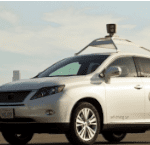 In the same week that driverless cars became street legal in the state of California, a week that saw Governor Jerry Brown travel from Sacramento to Mountain View and pay a visit to the Googleplex to sign SB 1298, a bill that created “a legal framework and safety standards for autonomous vehicles on state roads and highways,” the truth came out about why the latest, “safest” version of Google Maps, the mobile software which millions of people use as an automobile navigation device, is conspicuously absent in the new iPhone 5.
In the same week that driverless cars became street legal in the state of California, a week that saw Governor Jerry Brown travel from Sacramento to Mountain View and pay a visit to the Googleplex to sign SB 1298, a bill that created “a legal framework and safety standards for autonomous vehicles on state roads and highways,” the truth came out about why the latest, “safest” version of Google Maps, the mobile software which millions of people use as an automobile navigation device, is conspicuously absent in the new iPhone 5.
The “issue at hand:” Google refused to provide the same audible, turn-by-turn directions to Apple that it provides for its self-authored Android devices, forcing millions of iPhone users to take their eyes off the road!
Why should these two events be interlinked? First, because Google claims autonomous cars are proven to be safer, better drivers. If those claims are true, and we have no reason to suspect they are not, then as Mashable wrote, “Google has good reason to be proud; it is bringing us closer to the day when we’ll be able to sit back, relax and do the crossword during our commute.”
But if Google understands automotive safety and safety is paramount, why would they deliberately withhold a traffic safety feature used by tens of million of people? This is a feature of its software that makes it demonstrably less safe to do without. Thusly, “Do No Evil” which has purportedly been the guiding operating principle of the company’s decision-making from an ethical standpoint, is on trial in this event. Should one person whose eyes leave the road to find their “Next Tur” on a Google Maps app or Website without the Voice-Guided Maps feature, be injured or killed, it becomes a profoundly more disturbing moral issue.
And please, let us not forget in this age of wanton corporate expansion, the Android operating system was conceived by Google under the benevolent theory of “Open Source” software development. The premise is that Android is a Smartphone software platform that “ought to be free.” (Google does not charge Smartphone makers to use the software.) The more Smartphone users, the more Internet surfers, the theory goes. That’s good for Google. That being the case, offering a free, open source mobile platform to one group of people with one set of software, but selectively excluding another group, seems malevolent and contradictory.
Perhaps most ironically, one could argue, as Apple did rather convincingly in its recent trial against Samsung, the prototypical design of the Android OS interface adopted numerous conventions of the Apple iPhone, some of which (those in legal question) were found to be infringing to this day. Google chairman, Eric Schmidt sat in the Apple boardroom as a director during iPhone’s developmental days. Talk about biting the hand that “fed” you? No wonder Steve Jobs felt betrayed. Correlation? Causation? You decide.
Google had one more year on its contract to power Apple’s iPhone users with its mapping software services as a default, pre-installed App. But what it offered Apple was, in technical parlance, a “crippled version,” missing the best features. Besides audible, turn-by-turn voice navigation, Google also withheld its “vector art”-based maps sticking Apple with a version that used bitmapped pixels that forced the screen to redraw everytime a user wanted to scale the map up or down in size.

Apple’s new, in-house Maps App now contains vector-based graphics, their own, and it looks great. The presumption is that Apple will next use a voice like Siri’s to add audible, voice guided directions as soon as it can. It simply could not design that feature in the time it had available, ostensibly looking to successfully partner with Google.
We admire Google for its leadership in technology, but we believe that leadership ought to carry with it a strict adherence to a higher ethical and moral standard. Especially when lives could be at stake. [24×7]




















